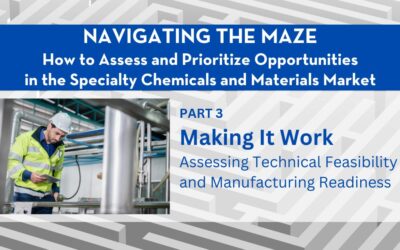Library: Resources & Media
Press Releases
ChemQuest Expands Business Development Team with New VP
The ChemQuest Group is pleased to announce that Ramki Subramanian, Ph.D., has joined its business development team as a vice president. Subramanian is a dynamic global leader who has spent 30 years developing expertise in technology development/commercialization and business development in the specialty chemicals, advanced materials, and energy sectors. He has considerable experience in championing “concept to commercialization” for new technologies and building new businesses by developing novel technologies, particularly in emerging markets.
Two New Directors Add Expertise to ChemQuest Team
The ChemQuest Group is pleased to announce the appointment of two new directors: John Giudici and William (Bill) Worms. An operations transformation leader, John has built considerable expertise in strategic planning and execution, manufacturing operations, performance and process improvements, product and quality management, and productivity optimization. Bill is a seasoned business executive with expertise leading public and private companies, associations, and employee stock ownership plan (ESOP) organizations.
Kevin Biller Inducted into Powder Coating Institute Hall of Fame
The ChemQuest Group is pleased to announce that Kevin Biller, director of ChemQuest Powder Coating Research, was inducted into the Powder Coating Institute (PCI) Hall of Fame at the conclusion of the organization’s annual meeting on May 30.
Market Reports
Articles
Can Paint Films Disrupt Traditional Coatings?
As industries evolve under increasing demands for sustainability, performance, and customization, new technologies are reshaping traditional practices. One such innovation is the rise of paint protection films (PPFs), also known as paint performance films. Originally developed for military applications, PPFs have grown into a versatile, high-performance alternative to conventional paints and coatings.
Navigating the Maze, Part 3: Making It Work – Assessing Technical Feasibility and Manufacturing Readiness
In the specialty chemicals and materials industry, a promising market opportunity means little if your organization can’t formulate, scale, or manufacture the product effectively. How should you assess technical complexity and production viability before committing major resources?
Powder Coatings with Purpose: Functional Technologies for Hygiene, Safety, and Surface Protection
In the world of powder coatings, the term “functional coatings” has historically been used to describe fusion-bonded epoxies used in pipeline and rebar applications. However, today’s powder coatings offer specialized functionalities that would fit in with the broader definition of that term. That is, they are specifically designed to provide a function beyond aesthetics and substrate protection.
Disrupting Markets by Inventing the Future: A New Paradigm in Innovation Strategy
The question that all innovators must answer is: “Does your innovation create market value?” The blueprint for how companies and innovators can thrive in a rapidly evolving marketplace hinges on adopting a market-driven approach to innovation, leveraging government and institutional support, and rigorously vetting opportunities so that businesses can position themselves at the forefront of change and transformation.
Navigating Challenging Times
High inflation and negative economic growth are certainly problematic on a macro level. However, the level of impact that those forces has on your company depends to a large degree on not only your organization’s overall fiscal health but its flexibility. Can you adapt quickly to changing market conditions? Are you able to adjust course effectively when faced with challenges, setbacks, or even roadblocks?
The PFAS Discussion: Update 2025
All producers and users of PFAS products should remain vigilant; this is not an issue where it makes sense to ignore the situation until it has been resolved by others. It is important to make sure that everyone involved is on top of the issues and determining their corporate actions based upon the direction in which regulatory actions on the issues appear to be trending.











